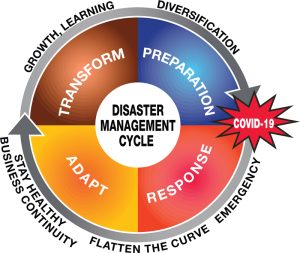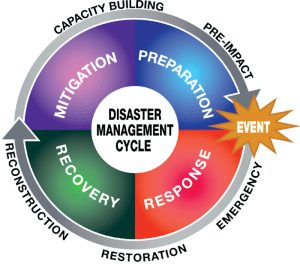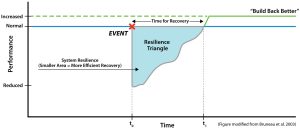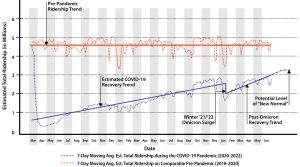Part 2: Performance Metrics to Measure Recovery
The NCSEA Resilience Committee is committed to educating the structural engineering community about the ever-evolving concepts of resilience and functional recovery. Adapt and Transform: COVID-19 Lessons for a More Resilient Future ran in STRUCTURE in October 2021. That article explored the concept of adaptability to the FEMA four-phase disaster management cycle characterized by “prepare, respond, recover, mitigate” (Figure 1) and considering the challenges and disruptions of the pre-vaccine COVID-19 pandemic.
The Part 1 article presented ideas about lessons learned from the COVID 19 hazard and some applications in a resilience context, using these lessons in building design in a traditional environmental hazard environment. While the characteristics of COVID-19 are somewhat distinct from other hazards because of the lengthy impact duration and worldwide effects, one can infer that climate change might represent a similar hazard for consideration. With this realization, the Committee observed that the prolonged response and recovery period had triggered a paradigm shift to a new normal. When applying this paradigm shift to the resilience triangle (Figure 2), one can recognize that the previously steady state of normalcy was not static. Before the pandemic, resilience was targeted toward recovering toward a “Build Back Better” target, which is now a political term because of legislation. Still, it has always been referenced when speaking about resilience, meaning to rebuild infrastructure that is better than the original.
Now we question the definition of “better” and the need or desire to replace damaged infrastructure at a level that may result in better performance during the next event. The COVID-19 pandemic shows us that the goal of resilience may not be shortening the time it takes to return to prior functionality post-hazard, typically called recovery. Instead, we may be better served to exploit the ability of a system that quickly evaluates real needs in a post-hazard environment to potentially identify a new functionality if warranted. This paradigm shift signals the need to consider adaptive resilience for infrastructure. Adaptive resilience is a concept that supports measuring recovery in a more holistic way, assuming that the recovery target may always be shifting. Adaptive resilience takes advantage of varying degrees of infrastructure functionality, encouraging flexibility in recovery.
This article strives to identify performance metrics that could be used to measure recovery assuming the need to recognize and incorporate adaptive resilience. For example, in the early phases of the pandemic, the New York City (NYC) Metropolitan Transportation Authority (MTA) published ridership data for public transport. Not unexpectedly, in April 2020, ridership dropped 93.3% from the 2019 weekday average. Before the pandemic, the MTA system carried 8.3 million riders on an average weekday. Over two years later, ridership has yet to return to normal, hovering around 60% of the pre-pandemic capacity (Figure 3). If one considers commuting via public transit as a recovery metric, NYC is far from recovered. However, consider that NYC has been evolving toward a new normal that requires less commuting for the past two years. The City may be recovered beyond what might be considered 60% of a pre-pandemic normal if we consider the characteristics of a post-pandemic state. Considering long commuting times commonly associated with working in NYC, it is likely that a hybrid work-from-home arrangement may contribute to a new normal for those who used to commute 5 days each week into the City but now commute 3 days each week, which contributes to the reported 60% of pre-pandemic levels. The FEMA disaster management cycle and the resilience triangle indicate that NYC falls short of a resilient response to the pandemic if using functionality applied to MTA ridership as a metric for the physical infrastructure dimension of recovery. However, suppose you look at how employees and companies have adapted to remote working in terms of computing power, versatility, flexibility, multi-tasking, and work-life balance. In that case, one can easily argue that NYC today is resilient and possibly more resistant to future hazards. Of course, adverse impacts of hybrid work-from-home arrangements on local businesses add an additional layer of complexity to this quandary. However, considering ridership, one can conclude that recovery may be complete.
Similarly, the NCSEA Resilience Committee also looked at digital monetary transaction data as a potential metric for recovery. Interestingly, the data revealed a significant increase in digital transactions as the world shifted from sales at brick-and-mortar stores to virtual ones. Overall, the search for recovery performance metrics proved very complex because individuals and communities did not seek to improve the affected infrastructure. Instead, the communities adapted and realigned with new technologies and processes that allowed for an acceptable level of functionality in a different context.

Because of this significant shift from single dimension recovery, the Committee moved away from attempting to isolate key recovery metrics and focused on how challenges are addressed (process-oriented resilience). The Committee considered that true resilience might be measured by returning to some desired performance or functionality that is not directly related to pre-event steady-state conditions. This realization validated the premise discussed in Part 1 by suggesting that communities are not recovering or mitigating following the FEMA disaster management cycle phases. Instead, they adapt and transform toward a more sustainable condition by being flexible and responsive (Figure 4).
In the past, evolving conditions were managed through defined time horizons (design life or mean recurrence intervals) and performance goals that assume a future condition that might or might not be science-based. But this assumption ignores that humans are adaptive, and our designs should consider that fact. For example, many employees never want to return to an office full-time now that it has been shown that high productivity is still possible with remote work. Likewise, because of the human decision factor, MTA ridership may never return to pre-pandemic levels (ignoring population growth).
The pandemic has, and will continue to, affect the built environment, but not as much as a single catastrophic event (e.g., an earthquake). So how can these pandemic-based lessons we are learning be implemented with new projects? We know that outcome-oriented resilience calls for projects that can withstand and be quickly repaired when subjected to extreme loading to provide for the continued use of functions within the building or infrastructure. In contrast, process-oriented resilience produces projects that are planned, implemented, and managed in a way that prepares for and adapts to changing conditions, both known and unknown (e.g., due to the pandemic or climate change). COVID-19 has taught us that when we do not know the outcome (a definite target to build towards, now thought of as “build back better”), we instead need to focus on the process we use to produce the most flexible future programs and systems.
A process that enhances resilience is referred to as resilience thinking, founded in systems theory. Resilience thinking focuses on maximizing a community’s capacity to meet future challenges, realizing the co-benefits of a project in real-time, minimizing negative consequences across social, environmental, and economic dimensions, and ultimately working towards improving people’s quality of life. The process, which seeds learning and adaptation, produces results with characteristics of a resilient system–reflective, resourceful, inclusive, integrated, robust, redundant, and flexible, instead of specific performance metrics. It assumes high uncertainty and low control over future conditions. It is constantly adapting to meet and exceed the identified needs of the population based on the desire for a specific performance or functionality, emphasizing functionality and livability in preparation for an uncertain future.
A key lesson from the pandemic might be to consider revising the hyper-specialized nature of today’s buildings. Amazon and Starbucks have taught people that they can have exactly what they want when they want it, which is fine for a pair of socks or a latte but not appropriate for a building that will be useful for more than 50 years. For example, imagine a new multi-story residential building built within a flood zone (a condition that is allowed in most jurisdictions). Today the building needs to have a particular unit mix, maximize the number of units, fall within the zoning envelope, meet the target of the current flood standards (along with other hazards), and a long list of other requirements. Architects and engineers are masters at squeezing all these requirements into the sausage maker to produce a building that will minimize first costs and maximize profits today. But what happens when the next Superstorm Sandy affects 13% of the U.S. population or the next global pandemic produces a decade-long (or longer) shift in the residential market?
Traditional thinking creates redundancy outside of the hazard area and reinforces assets within the hazard area. Now imagine the same building planned and designed using principles of adaptive resilience. To consider future relative sea-level change (or elevated river levels), the second floor could be designed to become the entry-level in the future, with the ground floor converted into wet floodproofed space. This design accepts potential future water levels rather than resisting them. Additionally, each clear floor height could be stretched to 10 or 11 feet, floors could be designed with a higher live load capacity, and building systems could transport vertically using designated shafts that can be shifted as necessary via floor knockout panels. Considering these changes, a residential floor today could be converted to an office or clinical floor 15 years later.
Certainly, today there are numerous challenges to this strategy with respect to zoning laws, elevator capacity, first costs, and rental/sale prices. But is it reasonable to focus only on the requirements of today when planning a $100M multi-decade investment? In addition, resilience thinking will stretch discussions of sustainability and carbon footprint as the first cost will undoubtedly increase, but the long-term impact can be better controlled. An adaptable building can also be designed to last 100 years instead of 50. Two $100M buildings constructed over 100 years represent a less effective investment than a $115M initial investment with $50M of reconfiguration during the same timeframe. Of course, there is a chance that the original $100M building can last for 100 years with general system maintenance – but the ever-increasing set of external threats does not support that theory.
The building industry and structural engineering profession are moving towards a focus on adaption and transformation, usually because the entitlement process prevents the development of large buildings in all but a few of the most vibrant metropolitan regions. Since resilience is adaptive and hard to quantify, people should shift their focus to attributes and characteristics. Planners, owners, and design professionals should keep a keen eye on the desired performance or functionality for a built system responding to the living world within a community context, using resilience thinking to holistically widen the aperture beyond a specific project. Understanding how a given asset connects to the living and built ecosystem becomes the focus. As we face future environmental hazards, pandemics, and climate change, we envision a new normal that holds a generational quality of life above all else.■
References
Rockefeller Foundation/ARUP, 2015. City Resilience Framework, www.rockefellerfoundation.org/report/city-resilience-framework



